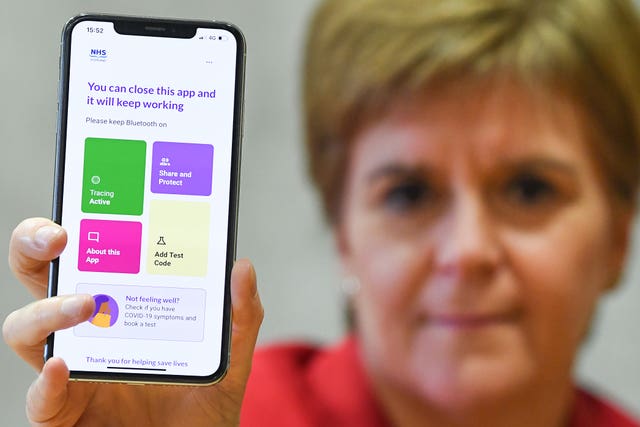Coronavirus contact tracing app: Key questions answered
The coronavirus contact tracing app for England and Wales is now available.

The technology in our pockets can now play a role in tracing the spread of coronavirus, with the launch of an app for England and Wales.
But how should the app be used, who should use it and will it even work on your smartphone?
Here, the PA news agency answers some of the crucial questions about the NHS Covid-19 contact tracing app:
– Do I have to use the app?
No, the app is entirely voluntary.
Businesses have started displaying QR code posters making it easier for anyone entering their facilities to scan and check in, but venues are expected to keep a paper log for anyone not using the app.
– What sort of smartphone do I need?
The app is available on iOS and Android operating systems but will not work on older handsets.
On the iPhone, you will need to be running iOS 13.5, meaning the oldest possible iPhone device you can use it on is 2015’s iPhone 6s.
On Android, Marshmallow 6.0 – released in 2015 – and higher is required.
NHS Test and Trace says this is because the app needs something called Exposure Notification, which Apple and Google developed together for it to work.
Those unable to access the app are urged to continue using traditional contact tracing services instead.

– Will it track my location?
No, the app does not request access to GPS features on your phone, meaning it can’t track your movements.
The only things the app will ask permission for is to use Bluetooth in the background, which essentially allows the contact tracing process to work.
It also needs notifications, to alert you if someone who was close to you has tested positive for the virus.
– What languages is it available in?
– English
– Welsh
– Bengali
– Urdu
– Gujarati
– Punjabi
– Chinese
– Romanian
– Turkish
– Arabic
There are plans to add other languages, including Polish.
– What if I live in Scotland and Northern Ireland?
Scotland and Northern Ireland have their own apps, called Protect Scotland and StopCOVID NI respectively.

The Department for Health and Social Care (DHSC) says it is continuing to work with both the Northern Ireland Executive and Scottish Government to understand how best the apps could complement each other.
The UK is also working with other app development teams across the world to create an app that can be used even while travelling in other countries.
– So, what if I travel to another UK nation or another country?
Apple and Google’s Exposure Notification technology will only allow the use of one official contact tracing app at a time.
So without a common app or compatibility in other countries for the moment, you will need to change your Exposure Notifications settings to switch between apps.
Open the app for the country you are in, and turn on contact tracing within that app.
A prompt will ask if you want to switch – but be sure to switch back when you return home.
– Do children need to use it?
No, it is for people over the age of 16.
– I’m not allowed my phone at work, what should I do?
There is a toggle to switch contact tracing off when you need to, found at the bottom of the app screen.
This should help avoid any false positives when your phone is in your work locker and not on your person.
When switching the toggle, it will ask if you want to set a reminder for when it should be switched back on.
– Will it actually make a difference?
The app has been pitched as an aid to contact tracing efforts.
NHS Test and Trace head Baroness Dido Harding has repeatedly said the technology is not a “silver bullet”.
Dr David Bonsall, scientific adviser to the Test and Trace Programme and senior researcher at Oxford University, said: “Even at lower uptake levels, the NHS Covid-19 contact tracing app will work within small networks of app users.
“Our Oxford University analysis suggests that every pair of friends using the app has the potential to prevent an infection.”





